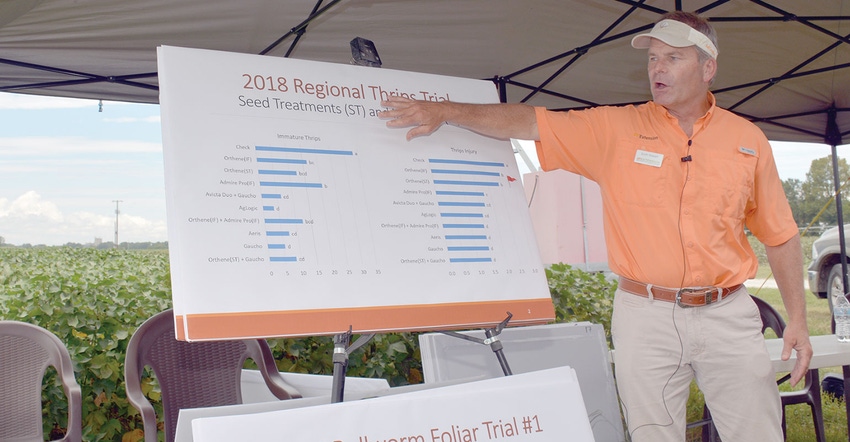
Scott Stewart, University of Tennessee Extension entomologist, says his recommendations for in-season plant bugs are mostly a rerun of what he said last year.
He also noted that imidacloprid insecticides continue to be effective as seed treatments against thrips and that spraying Bt cotton (BGII, TwinLink and WideStrike) is worth the expense if worm populations threaten yields.
Stewart discussed cotton insect control at a cotton field day recently at the West Tennessee Ag Research and Education Center in Jackson.
“All the imidacloprid insecticides are still hanging in there,” Stewart says. “It’s the only ‘base’ insecticide seed treatment that is providing acceptable control. But producers still might want to use something extra on the seed, perhaps acephate.”
But he did note some concern about possible acephate resistance. “Acephate has not looked very good in Tennessee,” he says. “We see some reduction in thrips numbers but not improved plant protection.” He says Intrepid Edge and Radiant have shown promise as acephate has fallen off.
Plant Bugs
“We have limited but effective tools for managing plant bugs,” Stewart says. “If farmers call me in July asking about mid-season plant bugs, I’ll talk a lot about Transform, Orthene, Diamond, and Bidrin. Those four are the most consistent insecticides we have for plant bug nymphs. Neonics are not very good and pyrethroids are not effective.”
He recommends combinations or alternating chemistries, “depending on what’s in the field. We have done a good job controlling plant bugs with several combinations.”
He says possible tank-mix options include: Orthene at 0.5 pound, plus Bidrin at 4 ounces; Transform at a reduced rate, plus Bidrin at a 4-ounce rate; Transform at a reduced rate, plus a half-pound of Orthene.
“We had good control with all these treatments,” he says. “It’s a good program for resistance management. And it’s not a good idea to put all your eggs in one basket. We want to mix it up a little bit, use multiple modes of action.”
Stewart says if bollworms get ahead of producers’ spray schedules on Bt or non-Bt cotton, they can’t expect to “zero out the population with one insecticide application.” Coming in late, he says, pits producers against large worms that have moved inside the bloom or the boll. “Prospects are better with timely applications.”
Prevathon or Besiege, diamide insecticides, generally looked good on bollworms, he says. “When we were late in our sprays this year, adding a pyrethroid to Prevathon or using Besiege seemed a little better. I would recommend a diamide with an extended moth flight, but when our application was a little late, having a pyrethroid component helped control bollworm.”
Resistance Issues
He says bollworms have developed “some level of resistance to several Bt toxins (Cry1F, Cry1A, and Cry2A).
“We need to take a more proactive approach with insecticides,” he says. “We have to be willing to spray those (older) Bt and WideStrike varieties. We will rely on diamide insecticides or new Bt technology.”
He says a $15 per acre treatment to protect the crop is not too expensive when you weigh it against potential yield loss.
Responding to an audience question about the new trait (VIP) in corn, Stewart said it creates problems.
“I’m not excited about using the VIP trait in corn. We are seeing no yield benefit, and I’m concerned about selecting for resistance in corn. We are now relying on the same VIP trait in Bollgard 3, WideStrike 3, and TwinLink Plus cotton. It is a concern.”
Graduate student Scott Graham discussed a new Bt technology that protects cotton from thrips. This technology is not commercially available yet, but Graham says over four site-years, the Bt trait has:
Provided excellent protection from thrips
Reduced plant bugs
Decreased plant bug injury, and
Decreased insecticide applications.
“Bt plots had fewer injured fruiting structures compared to non-Bt plots when left unsprayed, but insecticide applications were still needed for plant bugs to protect yield.” Graham says.
About the Author(s)
You May Also Like






